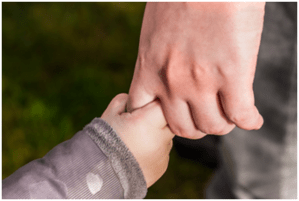Welcome Alyssa Caldbeck as our guest blogger this week as she explores navigating a child’s difficult emotions.
______________________________
Parenting is the most challenging job you’ll ever have. Weathering the storms of your child’s vast and varied emotions can feel like tricky territory. Experts on the subject of emotional intelligence say that it is best taught at home within the family. Dr. John Gottman and Dr. Daniel Goleman have written extensively based on research about the relationship between children and parents with regard to emotional intelligence in their book Raising Emotional Child The Heart of Parenting. They have found that when parents serve as an emotion coach for their children, those children adapt to difficult circumstances more readily.
Understanding Emotional Intelligence
Unlike intellectual intelligence which can be measured and is pre-determined potential for absorbing, recalling and utilizing information, emotional intelligence is learned. Emotional Intelligence is defined as the ability to recognize emotion, identify and name emotion, to manage those emotions in a way that is adaptive and to feel empathy for others. Emotional intelligence requires particular brain activity largely occurring in the front part of the brain (prefrontal cortex) which is headquarters for executive functioning skills. Young children are only beginning to develop the upper part of their brain. They don’t have all the pathways created in their brain to control themselves yet. Children are more likely to develop better coping mechanisms if parents help children learn how to identify their emotions. Additional aspects of helping children learn to handle their emotions effectively include assisting children in healthy emotional expression and teaching them to have empathy for others.

What is an Emotion Coach?
The term emotion coach is used in reference to a parenting technique where the parent helps their child understand their (the child’s) emotions. When parents engage in emotional coaching, their children learn how to react to emotions in healthy ways and more about how emotions work.
How Can You Be an Emotion Coach For Your Child?
Being an emotion coach with your child starts with you recognizing their emotions. Here are some steps you can take to be your child’s emotion coach and help your child handle their emotions.
1.Raise your own level of emotional awareness.
Practice noticing and naming your feelings rather than allowing your emotions to drive your actions.
- Become familiar with the continuum of parenting styles.
Aim to land in the middle of these parenting styles where you exercise authority when your child’s safety is at risk or healthy boundaries need to be set.
- Practice coping or calming strategies when you have overwhelming feelings of frustration, sadness or anger.
Take responsibility for your own feelings and actions. Know when it’s time to take a break. Practice deep breathing or another method to help you return to calm. When a human being’s limbic brain (that’s the headquarters for emotions, reactions and memory) becomes “flooded” the pre-frontal cortex (where reasoning and executive functioning occurs) goes offline temporarily . It’s best to give yourself some time and allow your limbic part of the brain to cool off and settle down. This will give you a better chance of returning to rational and reasonable thinking when responding to your child.
- Be a model for your child when it comes to emotions.
Allow your child to observe you identifying whatever emotions you experience. Give them chances to witness you making it a point to calm yourself before acting or speaking further. Once you are calm, return and explain how you are now ready to use your words and make decisions.
- When your child is beginning to experience an emotion, reflect with empathy.
An example would be “I can see you are beginning to feel frustrated that you can’t get the top of your PlayDough container. You really want to get it off. It seems to be stuck.” When your child has an experience of feeling heard and seen it helps them to begin to formulate their own ability to identify what they are feeling and why. Young children do not have words or the ability for abstract thinking (understanding why they are having their feelings). They do have an ability to learn new words that they can associate with the emotional experiences they are having. This helps the development of their executive functioning skills.
- Forego punishing and seek opportunities for teaching and learning.
It is understandable and common for you to have your own intense emotions when your child is experiencing big emotions. This is often when parents get to the point of disciplining a child for having these types of feelings. Trying to diminish big feelings by issuing consequences or punishment can actually create more of an emotional response. Your child may have emotions about the consequences issued and still be left with the emotion(s) they were feeling that got them in trouble. Teaching the child more appropriate ways of handling their feelings is missed when parents focus solely on punishments for emotional reactions.
- Catch feelings in their early stages with your child.
When you see feelings starting such as sadness or frustration speak to your child before their brain becomes fully flooded. Within that window you can wonder aloud about what might be going on.. An example would be, “I wonder how we could work together to get that lid off the PlayDough container.” You can join with your child to find possible solutions after you’ve reflected what you notice they are feeling. “If we think about it together we can find a way to get it open.” Emphasizing the “we” lets your child know they are not alone in dealing with their feelings and you are there to help them. Meeting the emotion being expressed before shifting into problem solving will help improve the outcome. Daniel Siegel’s video Connecting to Calm explains this more. He offers useful written information in this reference sheet.
- Find delight in your child often.
This is not the same thing as piling on the praise. Praise is when you as an extrinsic force decide your child is “good” or worthy of your approval. Delight and encouragement are when you reflect the child’s intrinsic qualities. Purposeful delight is when you notice your child’s effort, creativity, persistence, patience, joy and reflect with your own felt sense of celebratory noticing aloud. An example might be to smile and with an excited voice say, “Wow! Look at all the work you have done on this puzzle! You’ve been trying to find all the pieces and it looks like you’re almost there. You’ve kept trying and you almost have the whole puzzle together!”
- Avoid adding to the intensity of the emotion your child is experiencing.
Be with your child and allow them to express themselves. Let them get their feelings out while keeping them safe. Limit the talking you do with your child and avoid asking why they are acting this way. Children, even young toddlers can often have their own process when adults don’t interfere with this ability. What can happen is as adults we get impatient or focused on moving on from this experience or want it to end.
Despite a temper tantrum or intense emotional response feeling like it last forever this has shown to not be the case. When a person is emotionally triggered research has indicated it takes less than 90 seconds for the chemical surge to take hold and leave the bloodstream. The intensity related to the initial flooding of the emotions can peak and dissipate within this timeframe. Any response after 90 seconds is related to the person not letting go of the emotion or continued input feeding the same emotional loop (external input such as an adult talking to child, other sensory input or stimuli).
The key to keeping emotional responses within this timeframe is to feel the feelings, acknowledge them, and let them pass. This can be explained to children when they are in a calm state. It can be taught as imagining the emotion as a wave coming in and out or on the emotion moving away by floating on a cloud. Adults can practice the same strategies to not let their emotions linger.
- Accept all feelings and realize children will experience negative emotions.
A child’s emotions are not always logical and may seem to come out of nowhere. However, a child’s feelings are very real to them. Adults are not happy all the time. The truth is we don’t always handle our feelings the best. Children are not little versions of adults. It is not realistic to expect a child to always handle their emotions when we as adults struggle with this too. Children need to be able to have an array of feelings (positive, negative, big feelings) and it be OK.

Why Be an Emotion Coach For Your Child?
As a parent, you are the main influence in shaping your child’s abilities to work through the natural emotions of childhood. By working to help them develop emotional intelligence you are empowering and supporting the development of an intrinsic sense of worth and value. You set the tone and example for whether it is possible to experience emotions and get through these feelings without letting the feelings overtake and drive actions and responses. Starting this process and teaching early gives children the ability to build on having the success of handling their emotions effectively.
Conclusion
Rather than feeling like this is one more feat you have to tackle as a parent simply find daily opportunities to label, model, and practice emotions. This can be done by identifying emotions in everyday situations. Have an open discussion of what the emotion being displayed is and what could be done to handle the emotion in an appropriate way.
Embarking on the journey of serving as your child’s emotion coach can be an important step you take for yourself, your family and your child’s development.

_________________________

Alyssa Caldbeck, LISW, RPT

If every parent could be an emotion coach for their child just think of the impact it would have on generations to come! Great info here!
Great piece! All parents and teachers need to read this!